Granada
Granada was the capital of the Zirí Kingdom of Granada during the 11th century, and of the Nasrid Kingdom of Granada between the 13th and 15th centuries. After the capture of the city by the Catholic monarchs, it remained the capital of the Castilian Kingdom of Granada, which was already a simple territorial jurisdiction. It remained so until 1833, at which time there was a new provincial division in Spain which is still in force today. Among its historical buildings, the Alhambra is one of the most important monuments in the country, declared a World Heritage Site by UNESCO in 1984, next to the Generalife garden and the Albaicín. Its cathedral is considered to be the first Renaissance church in Spain.
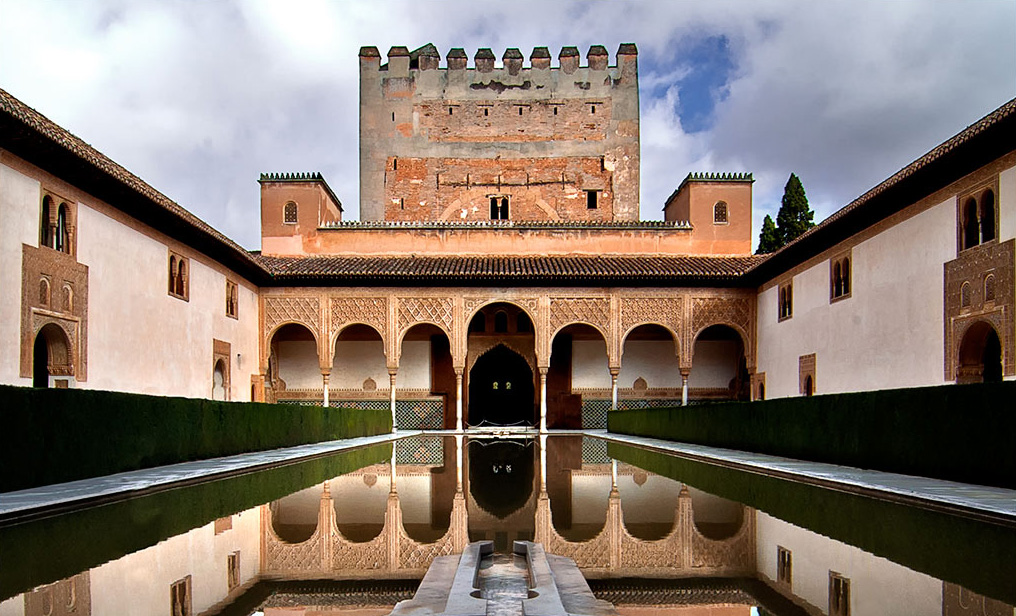
Technical Information
The Urban Timemap is primarily designed for PC’s and Mac’s using any of the available browsers with HTML5 technology. Urban Timemaps are online cross-platform applications which run on smartphones and tablets as well, especially if they run Android. For iPhones please use the specific app
Locations
1 – Alhambra Palaces
2 – Alhambra Alkazaba
3 – Plaza Nueva
4 – Bib-Rambla – Catedrala
5 – Isabel la Catolica – square
The locations can be visited on a loop in both directions, while Map view provides possibility to choose directly from these stations (1-5).
The periods modelled are most representative of the city of Granada because they mark the history and the expression of the city today. The first period of 1490 marks the city of Granada as the last occupation of Muslim domination in Europe, with the Nazari kingdom. The 700 years of occupation marked the city through culture and architecture, such as the Madraza, the Corral del Carbón or the Alhambra. Moreover, the network of streets and alleys is typical of a Muslim medina, which were reflected in neighborhoods like the Albaicín. The second period of 1650 was chosen for being representative of the city after the Muslim domination, heralding in the great Christian era. This era produced a number of Renaissance and Baroque buildings which still survive today.
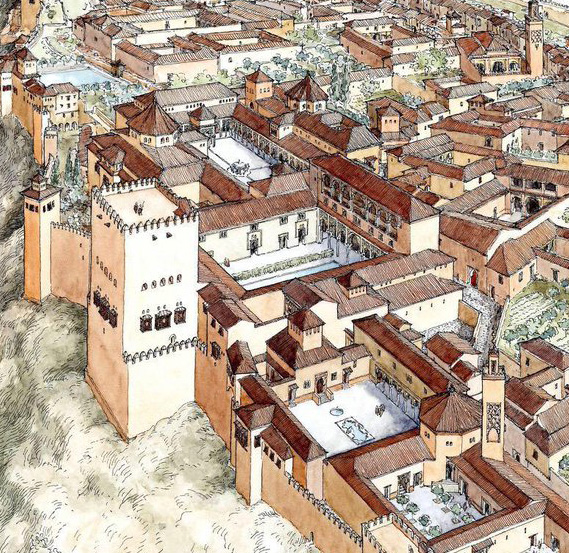
The two major periods chosen represent the history of the city because they are the most urban and architectural changes which contributed to the current city of Granada occurred during these periods. Many of these changes remain a symbol for the city, as the fortress Alhambra with the Nazari kingdom that will mark the economy and society of Granada until 1492, with all its typical houses, streets, mosques, cisterns, walls, doors, squares, with a large network of water supply and drainage, etc., and that will mark districts of Granada that still they last with the Realejo, Albaicin, Sacromonte, etc. The following period marks the current city of Granada, with the beginning of the first Christian constructions, when the Moorish uprising was finally crushed in 1571, after the death of Aben-Humeya. This period marked political stability for the city, where the Catholic religion expanded strongly with the construction of churches, convents and monasteries throughout the city, in many cases adapting the old mosques.

These time periods chosen are well-researched from a historical and archaeological point of view. Therefore, to carry out the research on these different buildings in the city of Granada, we have consulted the numerous publications that exist, carried out by researchers from the University of Granada (Vilchez Vilchez C., Puerta Vilchez JM, Barrios Rozua JM; Seco de Lucena Escalada L .; etc). These documents provide us with data and dates of the most important buildings in the city, and in some cases they show us plans and surveys of the floors of the buildings. They give us some interpretations of the most complete “Plan of the Arab Granada” that is known of the Muslim Granada of Luis Seco de Lucena made in 1910, based on the archaeological remains that still exist in the city and many others that today they have lost.
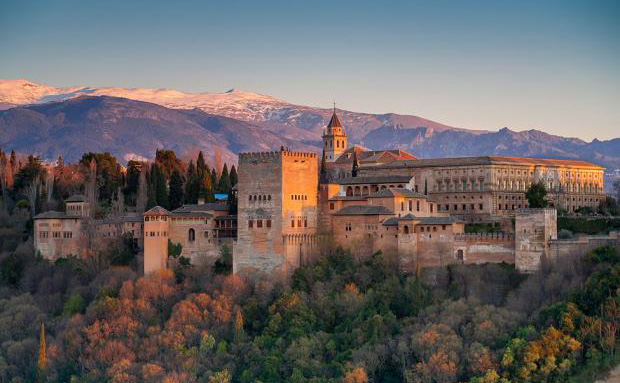
Alhambra
 The Alhambra Complex (which includes the Alcazaba and numerous palaces) has a long and extensive history of modification, with the general consensus understanding that the earliest foundations of the Alcazaba (fortified military structure) date from the Roman era. Then, the first Arab constructions of the fortified military enclosure date from the Umayyad Caliphate period and was expanded by the Zirids in the 11th century. However, the main construction on this site was the Alhambra Complex of the Nasrid era, which saw the Alhambra become one of the most symbolic icons of power, prestige and beauty, as well as being illustrative of Islamic presence and influence.
The Alhambra Complex (which includes the Alcazaba and numerous palaces) has a long and extensive history of modification, with the general consensus understanding that the earliest foundations of the Alcazaba (fortified military structure) date from the Roman era. Then, the first Arab constructions of the fortified military enclosure date from the Umayyad Caliphate period and was expanded by the Zirids in the 11th century. However, the main construction on this site was the Alhambra Complex of the Nasrid era, which saw the Alhambra become one of the most symbolic icons of power, prestige and beauty, as well as being illustrative of Islamic presence and influence.
Alhambra Royal Mosque
The Royal Mosque was built by Muhammad III in 1305, almost in the same place where the Church of Santa Maria de la Alhambra is located today (the baptismal font was an ancient Spanish-Muslim source), on the main street of the palatine city, Calle Real. This site was chosen because Friday prayers led by the monarch were held in common, between servants and soldiers. Properly oriented to the southeast, the central axis of the former mosque is located under the south side of the current church.
Santa Maria de la Alhambra
In 1492 the Royal Mosque was converted into the Church of St. Mary of Alhambra, being dedicated to St. Mary, as decided by the Catholic monarchs. Therefore, only the function of the space within the building had changed, with the former Mosque being extended to include a chancel added at the base. However, the Royal Mosque was subsequently demolished by the Catholic monarchs, beginning the building’s journey of modification.
San Francisco Convent
San Francisco Convent was built by the Catholic monarchs in 1494 on the site of the Nasrid palace, the palace of the infants of Muhammad III (1303-1309). In 1521 the Catholic Kings (Isabel and Fernando) were buried in the convent chapel for the first time, until Carlos V ordered the Count of Tendilla to be buried in the place they now occupy: the Royal Chapel of Granada, attached to the current Cathedral Church. The Franciscans abandoned the monastery in 1835 and it was subsequently used as a barracks for the rest of the 19th century. Under the direction of the architect Leopoldo Torres Balbás, the building was rescued from almost total ruin between 1927 and 1936, being converted into a residence for painters. The area is used today as a hostel.
Alcazaba
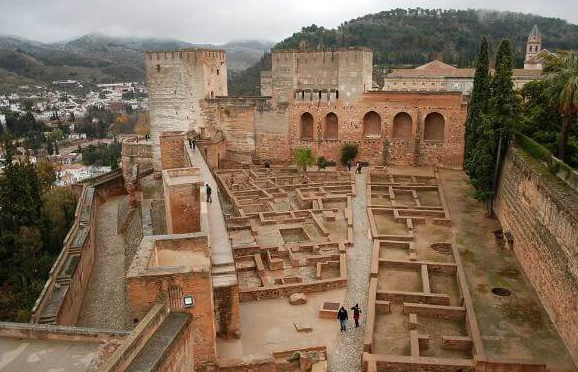 The Alcazaba is located in the westernmost part of the hill of Sabika. It was the military zone, centre of the defense and surveillance of the site and with it was the oldest part of the Alhambra construction. The first hispano musulmanas buildings built correspond to the caliphal period, in the eleventh century, expanding them to become the capital in Granada of one of the kingdoms of Taifas. With Muhammad I, first Nasrid king of Granada, this fort was rebuilt and expanded, its walls were reinforced and the main towers were erected. His successor Muhammad II completed the reconstruction works of the citadel.
The Alcazaba is located in the westernmost part of the hill of Sabika. It was the military zone, centre of the defense and surveillance of the site and with it was the oldest part of the Alhambra construction. The first hispano musulmanas buildings built correspond to the caliphal period, in the eleventh century, expanding them to become the capital in Granada of one of the kingdoms of Taifas. With Muhammad I, first Nasrid king of Granada, this fort was rebuilt and expanded, its walls were reinforced and the main towers were erected. His successor Muhammad II completed the reconstruction works of the citadel.
Alhambra Nazari Palaces
The Nasrid palaces are the set formed by the Palace of Comares, constructed first, and the Palace of the Lions. Chronologically they were raised after the citadel, the Generalife and the Partal, being constructed in the first third of the fourteenth century. It was the seat of the administrative functions of the court, protocol and retirement, and private entertainment.
Palace Of Comares
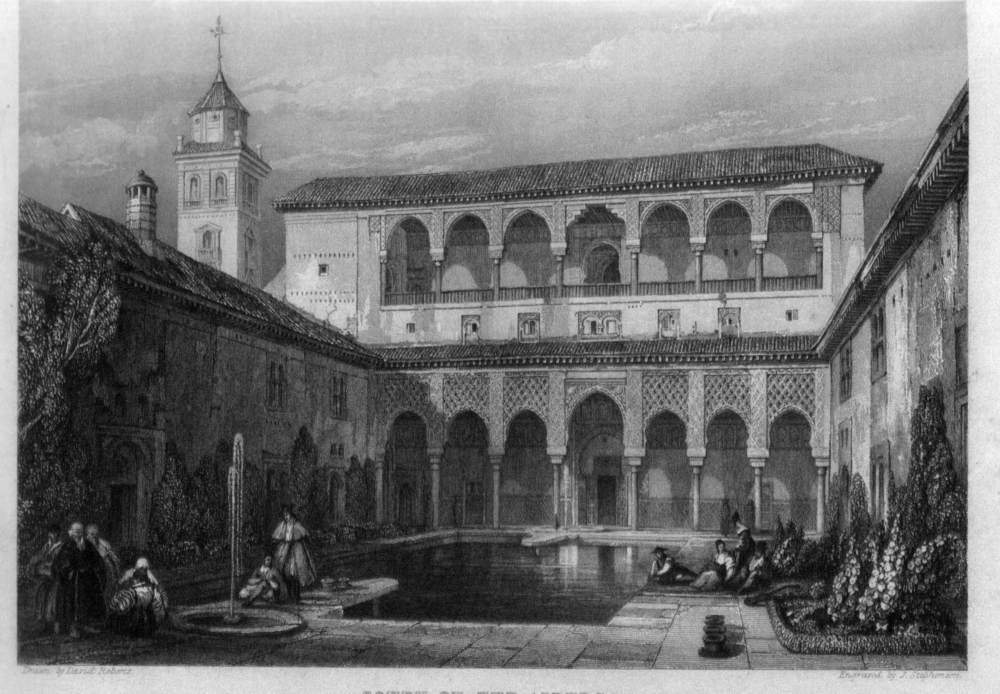 The Fourth or Palace of Comares was the official residence of the monarch, and is comprised of a set of buildings grouped around the Patio de los Arrayanes, with porticoed galleries at the ends, located to the north of the Sala de la Barca and the Sala de los Ambassadors, which occupies the interior of the Torre de Comares. Yusuf I wanted the decoration of his official residence to leave the visitor in awe, so he ordered it to be exquisitely built and decorated, although he probably did not see this work ever finished, since several inscriptions attribute his authorship to his son Mohamed V, who completed the work.
The Fourth or Palace of Comares was the official residence of the monarch, and is comprised of a set of buildings grouped around the Patio de los Arrayanes, with porticoed galleries at the ends, located to the north of the Sala de la Barca and the Sala de los Ambassadors, which occupies the interior of the Torre de Comares. Yusuf I wanted the decoration of his official residence to leave the visitor in awe, so he ordered it to be exquisitely built and decorated, although he probably did not see this work ever finished, since several inscriptions attribute his authorship to his son Mohamed V, who completed the work.
Palace of the Lions
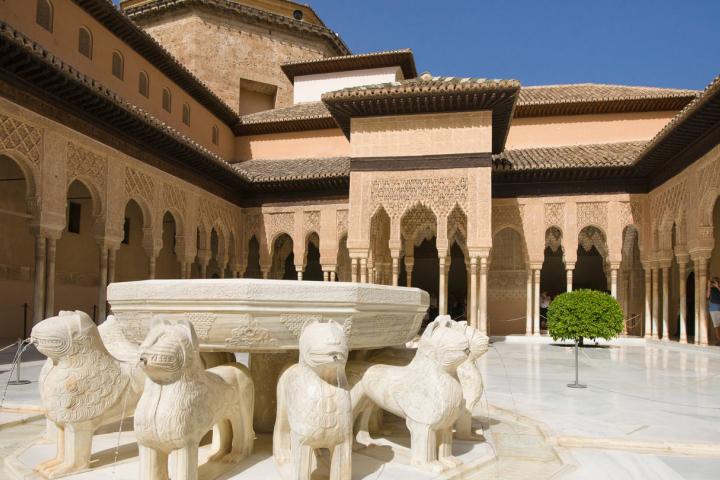 When Mohamed V succeeded his father Yusuf I, he did not just finish the reforms he had begun, but he started to build what would be his great work, the magnificent legacy he left us in the Alhambra: the Palace of the Lions. This palace constituted the private rooms of the royal family, and was built in the angle formed by the Baths and the Patio de los Arrayanes. The palace is composed of a central courtyard surrounded by galleries of columns like a Christian cloister, allowing access to different rooms: west of the Mocarabes, east of the Kings, north of Dos Hermanas, Ajimeces and Mirador de Daraxa and to the south that of the Abencerrajes and the Harem.
When Mohamed V succeeded his father Yusuf I, he did not just finish the reforms he had begun, but he started to build what would be his great work, the magnificent legacy he left us in the Alhambra: the Palace of the Lions. This palace constituted the private rooms of the royal family, and was built in the angle formed by the Baths and the Patio de los Arrayanes. The palace is composed of a central courtyard surrounded by galleries of columns like a Christian cloister, allowing access to different rooms: west of the Mocarabes, east of the Kings, north of Dos Hermanas, Ajimeces and Mirador de Daraxa and to the south that of the Abencerrajes and the Harem.
Charles V Palace
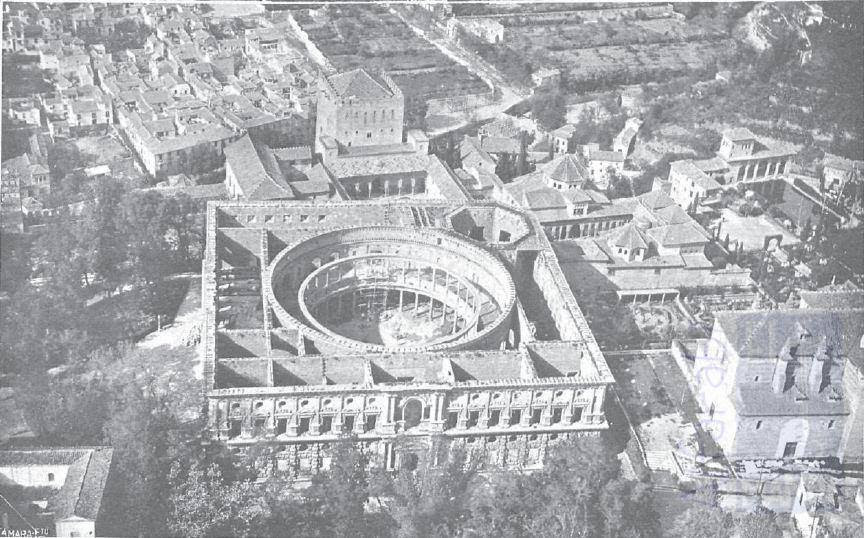 The Palace of Charles V began being constructed in 1526, under the orders of Emperor Charles V. The architect Pedro Machuca oversaw the works of the Palace from 1533 until his death in 1550. Nonetheless, the Palace experienced another structural change by Luis Machuca, who developed the iconic circular courtyard and who took over from his father in constructing the Palace. In 1619 the construction of the high colonnade of the courtyard was completed and the works continued until 1637, when construction on the Palace was totally abandoned. The Palace remained unfished until Leopoldo Torres Balbas created a plan to recover the historical building in 1923.
The Palace of Charles V began being constructed in 1526, under the orders of Emperor Charles V. The architect Pedro Machuca oversaw the works of the Palace from 1533 until his death in 1550. Nonetheless, the Palace experienced another structural change by Luis Machuca, who developed the iconic circular courtyard and who took over from his father in constructing the Palace. In 1619 the construction of the high colonnade of the courtyard was completed and the works continued until 1637, when construction on the Palace was totally abandoned. The Palace remained unfished until Leopoldo Torres Balbas created a plan to recover the historical building in 1923.
Plaza Nueva
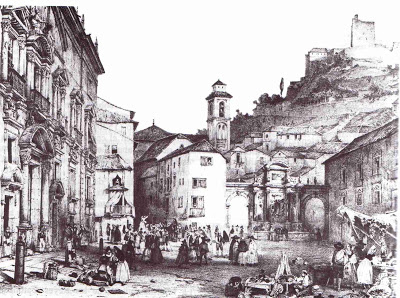 The current configuration of the Plaza Nueva is the product of successive transformations initiated with the widening of the Alhachimín Bridge or the Bath of the Crown, built in the Zirí period throughout the eleventh century. The widening, carried out by the master Alí de Medina in 1499, consisted of the addition to the old bridge of flagstones and stone from a brick arch of 1.92 meters wide. Six years after these works, the Cabildo of Granada asked the Crown for permission and funds to develop a plaza in this place that ennobled the city. The works, begun in 1506 and completed in 1515 by the stonemason Miguel Sánchez de Toledo, consisted of embedding seventy-two meters of the course of Darro River. In 1531, the vault was expanded again covering fifty meters more, upstream of the river, in front of the facade of the Chancilleria Palace. Thus it was configured Plaza Nueva until 1835, the year in which the pillar of the Nymphs, which separated it from the Plaza de Santa Ana, was destroyed by an overflow of the Darro River, leaving both spaces together.
The current configuration of the Plaza Nueva is the product of successive transformations initiated with the widening of the Alhachimín Bridge or the Bath of the Crown, built in the Zirí period throughout the eleventh century. The widening, carried out by the master Alí de Medina in 1499, consisted of the addition to the old bridge of flagstones and stone from a brick arch of 1.92 meters wide. Six years after these works, the Cabildo of Granada asked the Crown for permission and funds to develop a plaza in this place that ennobled the city. The works, begun in 1506 and completed in 1515 by the stonemason Miguel Sánchez de Toledo, consisted of embedding seventy-two meters of the course of Darro River. In 1531, the vault was expanded again covering fifty meters more, upstream of the river, in front of the facade of the Chancilleria Palace. Thus it was configured Plaza Nueva until 1835, the year in which the pillar of the Nymphs, which separated it from the Plaza de Santa Ana, was destroyed by an overflow of the Darro River, leaving both spaces together.
Maristan
The Maristan is a historical building of immense importance, due to the insight we are able to have into Sultan Muhammad V’s approach to social dilemmas and charity, such as the outbreak of the Black Plague in Europe. The Maristan was a hospital with the aim to provide healthcare for the poor and needy, in a safe space, as well as being Europe’s first insane asylum to assist the mentally ill (although often the Maristan is not given its due credit). After the Reconquista the function of the Maristan was modified, with it first becoming a minting house until the 17th century. Subsequently, it became a wine store and even functioned as a prison at one point. However, in 1843 the Maristan would forever be changed, as it was demolished with only the bare skeletal structure being visible today. There are currently plans to restore and preserve the Maristan, but it has been left in a state of abandonment for many years now.
Santa Ana Church
 The Santa Ana Church was erected in the year 1537. According to Diego de Siloé’s project, the most renowned artist of the time in his area, the lot was expanded by the purchase of farms previously occupied by the aljama mosque Almanzora. It basically consists of a single nave to which side chapels, the main chapel and sacristy are attached. The church has five chapels on each side of the nave covered with Mudejar coffered ceilings and a main chapel covered by loop armor. The tower, built between 1561 and 1563 by Juan Castellar, is brick like the rest of the temple, very slender, with four sections of holes centered on its main face, organized from lowest to highest in its order of height.
The Santa Ana Church was erected in the year 1537. According to Diego de Siloé’s project, the most renowned artist of the time in his area, the lot was expanded by the purchase of farms previously occupied by the aljama mosque Almanzora. It basically consists of a single nave to which side chapels, the main chapel and sacristy are attached. The church has five chapels on each side of the nave covered with Mudejar coffered ceilings and a main chapel covered by loop armor. The tower, built between 1561 and 1563 by Juan Castellar, is brick like the rest of the temple, very slender, with four sections of holes centered on its main face, organized from lowest to highest in its order of height.
The Royal Chancillery
The Mannerist-style facade of the Royal Chancery is an exceptional contribution to the historical landscape in Granada, with its architecture being a subtle blend of Classical and Baroque styles. The bell-tower, patio, balustrade and facade are strongly influenced and emblematic of the Italian Mannerist style. The facade, envisioned as a symbol of power, implied the presence of the Crown in Granada. The Royal Chancery is organised into two horizontal sections of two stories and seven vertical panels. The courtyard, usually attributed to Diego de Siloé, has half arches held up by high Tuscan pillars made of white marble.
Plaza de Isabel la Catolica
The sculpture of Queen Isabel and Christopher Columbus on Calle Reyes Catholicos is of monumental scale not only due to the size of the sculpture, but also its central location within the city. It was created in 1892 by a Valencian sculptor (born in 1862) at the height of artistic Realism. It was made as a commemorative monument for the 400th anniversary of the Discovery of America by Christopher Columbus. The work was made in Rome and later transferred to Granada, with the original location being in Paseo de Salon, however the City Council had later decided to relocate it to its current location in Plaza de Isabel La Católica. There is a real sense of realism in the sculpture. One of the key modifications of this historical structure was the remodelling of the plaza surrounding it.
Corral Del Carbón
 The Corral del Carbón was distinctly of Nasrid architectural style and believed to be built before 1336. Before 1494, the building was known as Al-Funduq al- Gidida, which was an inn for travelling merchants and their merchandise. The upper levels of the Funduq was where the merchants would rest, and the ground level being where their merchandise and live stock would be held. In 1494 the Catholic monarchs had granted the building of the Funduq to Sancho de Arana; however at his death in 1531 the Funduq was put up for auction in March of that year. The building first became a lodging area for charcoal burners, then as a corral of comedies (theatre) until 1593, then finally became privately owned. Surprisingly, few structural modifications took place on this site. In 1918 it was declared as a National Historic-Artistic Monument, until it was acquired by the State in 1933, which encouraged and commissioned its restoration and preservation to Leopoldo Torres Balbás. Restoration of the Corral del Carbón and the intervention of the State was finished in November 2006.
The Corral del Carbón was distinctly of Nasrid architectural style and believed to be built before 1336. Before 1494, the building was known as Al-Funduq al- Gidida, which was an inn for travelling merchants and their merchandise. The upper levels of the Funduq was where the merchants would rest, and the ground level being where their merchandise and live stock would be held. In 1494 the Catholic monarchs had granted the building of the Funduq to Sancho de Arana; however at his death in 1531 the Funduq was put up for auction in March of that year. The building first became a lodging area for charcoal burners, then as a corral of comedies (theatre) until 1593, then finally became privately owned. Surprisingly, few structural modifications took place on this site. In 1918 it was declared as a National Historic-Artistic Monument, until it was acquired by the State in 1933, which encouraged and commissioned its restoration and preservation to Leopoldo Torres Balbás. Restoration of the Corral del Carbón and the intervention of the State was finished in November 2006.
Gran Via de Colón Street
On August 20 1895, the Granadina Reformer was granted the works of the Gran Vía. At the same time that the works were developed, the majestic buildings that flank it were erected. On March 26, 1897, the first stone was laid for the construction of the Church of the Sacred Heart of Jesus and it was inaugurated on November 16, 1898. With an acute difference to the aspect it presents today, the Gran Vía was provisionally completed on September 9 1903. From here, the construction of buildings and the opening of businesses occurred exponentially.
Central Bank Building
The 20th-century Banco Central building is directly opposite the sculpture of Isabel and Christopher Columbus on Calle Reyes Catholicos. The Banco Central is an interesting example of early 20th-century European architecture, which features many colonial elements, reflective of the attitudes and policies of Europe at the time. The building is also a copy of the building in Paris which dates from the late 19th century. The Banco Central was renovated in the 1950’s.
Bib-Rambla
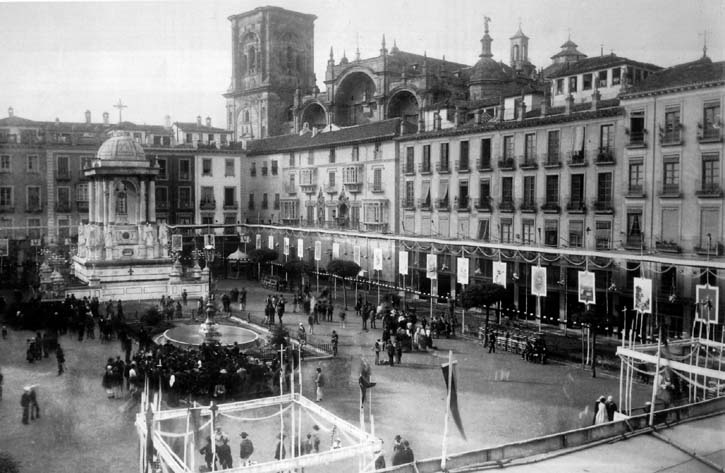 The Bib-Rambla and Cathedral date back to the Nasrid period, and plays an important role due to its proximity to the commercial core of the city located in the Alcaicería and Zacatín. After its remodeling in the late sixteenth century, its size was similar to the current one. Around the middle of the 20th century, Príncipe Street was opened to connect the Bib-Rambla square with the street of Reyes Católicos. In its current configuration it is a rectangular square presided over by the fountain of the Giants of pagan motifs and bucolic details typical of a commercial plaza. The ends of the square is decorated by late 19th-century iron fernandine lampposts from a foundry of Seville.
The Bib-Rambla and Cathedral date back to the Nasrid period, and plays an important role due to its proximity to the commercial core of the city located in the Alcaicería and Zacatín. After its remodeling in the late sixteenth century, its size was similar to the current one. Around the middle of the 20th century, Príncipe Street was opened to connect the Bib-Rambla square with the street of Reyes Católicos. In its current configuration it is a rectangular square presided over by the fountain of the Giants of pagan motifs and bucolic details typical of a commercial plaza. The ends of the square is decorated by late 19th-century iron fernandine lampposts from a foundry of Seville.
Aljama Mosque
The great mosque of Granada was the religious and cultural centre of the city. Its construction started in the tenth century, by Zawi ibn Ziri, and their descendants, the Zirids, embellished it with sturdy chestnut wood doors and fragrant African Atlas cedar. Its majestic richness invited the believer to pray inside its eleven ships 10 feet wide, topped with gabled roofs, supported by rows of thirty white marble columns of Macael surmounted by Caliphate capitals from the plundering of the old Umayyad capital. A large fountain presided over the narthex, the center of the ablution patio and the main minaret stood in front of the patio, a free tower with a square floor of 4.5 metres on each side, of free stone, with a height of 13.5 metres.
Madraza
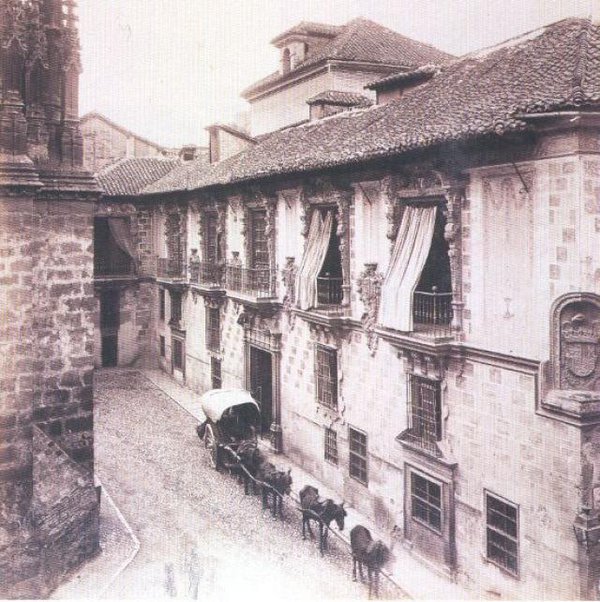 The Madraza was constructed by Sultan Yusuf I in the mid-14th century. It held great cultural, social and educational significance for the Muslims of Granada,especially when considering the fact that the Madraza was in close proximity to the notable areas of commerce, religious establishments and socialisation. The first major modification to the Madraza was after the Reconquista, when it lost its functions as a social, educational and cultural institution. Thus, in the early 16th century, the Catholic monarchs had made use of the building by placing the Council and the Town Hall within what previously was the Madraza, and renamed it the Casa del Cabildo. The building is still standing today
The Madraza was constructed by Sultan Yusuf I in the mid-14th century. It held great cultural, social and educational significance for the Muslims of Granada,especially when considering the fact that the Madraza was in close proximity to the notable areas of commerce, religious establishments and socialisation. The first major modification to the Madraza was after the Reconquista, when it lost its functions as a social, educational and cultural institution. Thus, in the early 16th century, the Catholic monarchs had made use of the building by placing the Council and the Town Hall within what previously was the Madraza, and renamed it the Casa del Cabildo. The building is still standing today
Cathedral
 The Cathedral of Granada is the epitome of structural grandness, due to the imposing three main facades of the Cathedral, which aimed to remind the faithful of their insignificant nature. Diego de Siloé spent forty years devising the structure of the Cathedral, conceptualising five naves rather than the traditional three naves and the triforium. Different architectural styles exist within the Cathedral. Diego de Siloé was successful in convincing the reluctant Emperor Charles V of the potential of demonstrating Christian spirituality within pagan architecture, especially of the Greeks and Romans. Subsequent architects included Juan de Maena (1563-1571), Juan de Orea (1571-1590), and Ambrosio de Vico (1590-?). In 1667 Alonso Cano, working with Gaspar de la Peña, altered the initial plan for the main facade, introducing Baroque elements. Use of the Baroque was seen as a way to counter the effects of the Reformation of the 16th and 17th centuris, to highlight the excellence and splendour offered by Catholicism. The building has been conserved and is still standing today.
The Cathedral of Granada is the epitome of structural grandness, due to the imposing three main facades of the Cathedral, which aimed to remind the faithful of their insignificant nature. Diego de Siloé spent forty years devising the structure of the Cathedral, conceptualising five naves rather than the traditional three naves and the triforium. Different architectural styles exist within the Cathedral. Diego de Siloé was successful in convincing the reluctant Emperor Charles V of the potential of demonstrating Christian spirituality within pagan architecture, especially of the Greeks and Romans. Subsequent architects included Juan de Maena (1563-1571), Juan de Orea (1571-1590), and Ambrosio de Vico (1590-?). In 1667 Alonso Cano, working with Gaspar de la Peña, altered the initial plan for the main facade, introducing Baroque elements. Use of the Baroque was seen as a way to counter the effects of the Reformation of the 16th and 17th centuris, to highlight the excellence and splendour offered by Catholicism. The building has been conserved and is still standing today.
The Royal Chapel
The Royal Chapel styled in Isabelline Gothic architecture began its construction in 1505 by Enrique Egas. The floor plan is in the shape of a Latin cross with four side chapels. The institutionalisation of the Royal Chapel – ensuring it was financially viable to reach completion – and the need for its completion came about as Queen Isabel died one year before its construction. Thus, modification of the structural building and architectural style was not of such diversion to the original blueprints, expect for Charles V demanding the Royal Chapel being more luxurious, befitting for his grandparents. The building has been conserved and is still standing today.
Archbishop Palace
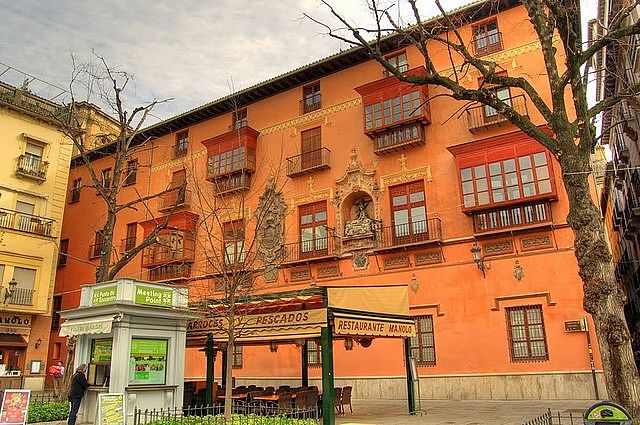 The Archbishop’s Palace was built between 1528 and 1540 and is usually attributed to Diego de Siloé. However, the Palace was completely destroyed by fire in December 1982. The Palace was open to the public once more twenty years later, housing a permanent museum within the historical building. The architectural style is Baroque, including an interesting 17th-century courtyard with austere lines. This three-storey courtyard has all its open fronts through galleries of arches resting on Tuscan-style columns and white marble stalks. Originally, the Palace had its entrance through the square of the Bib-Rambla, but after the rebuilding and restoration, the main entrance was closed.
The Archbishop’s Palace was built between 1528 and 1540 and is usually attributed to Diego de Siloé. However, the Palace was completely destroyed by fire in December 1982. The Palace was open to the public once more twenty years later, housing a permanent museum within the historical building. The architectural style is Baroque, including an interesting 17th-century courtyard with austere lines. This three-storey courtyard has all its open fronts through galleries of arches resting on Tuscan-style columns and white marble stalks. Originally, the Palace had its entrance through the square of the Bib-Rambla, but after the rebuilding and restoration, the main entrance was closed.
Credits
Models were built Andras Finta, Tektum
Interactive contents were assembled by
Gábor Palotás, EK Association
Textures by Digitalis Legendarium & Doctum
Design by Marianna Carazzai
Research materials by Doctum
Which other city has a castle?
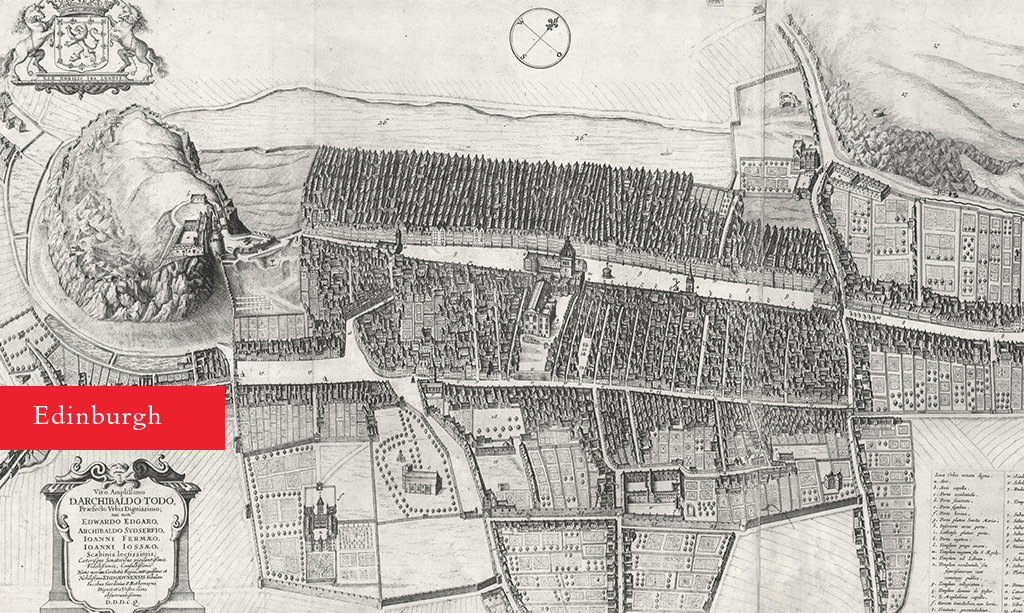
Edinburgh
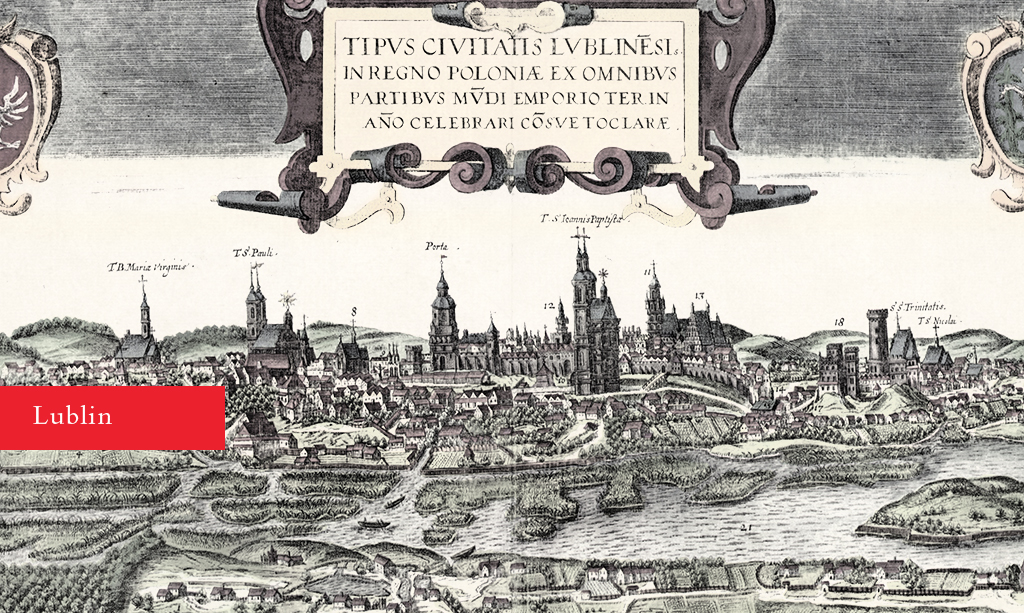
Lublin
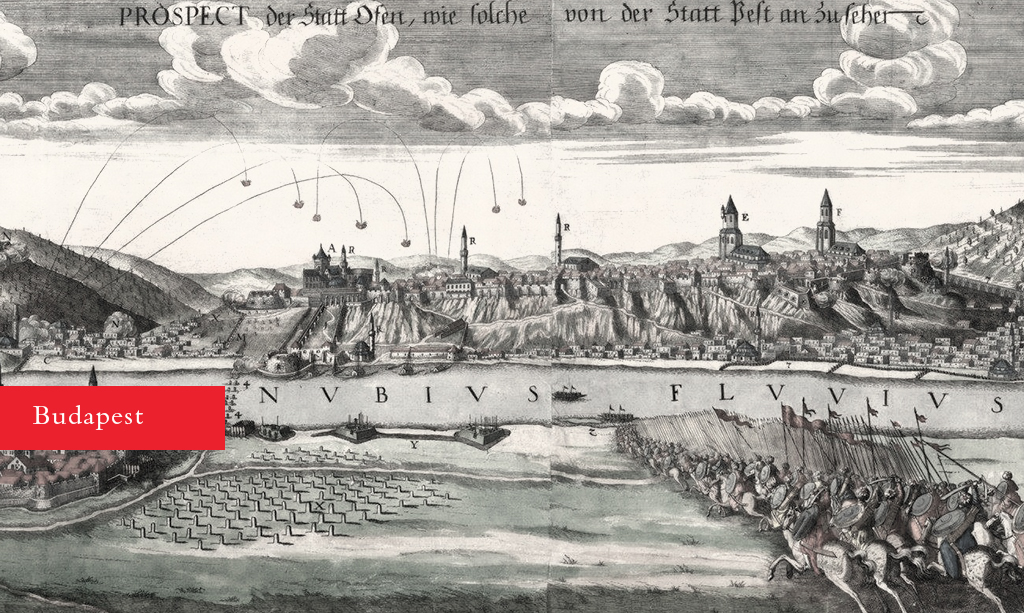
Budapest
